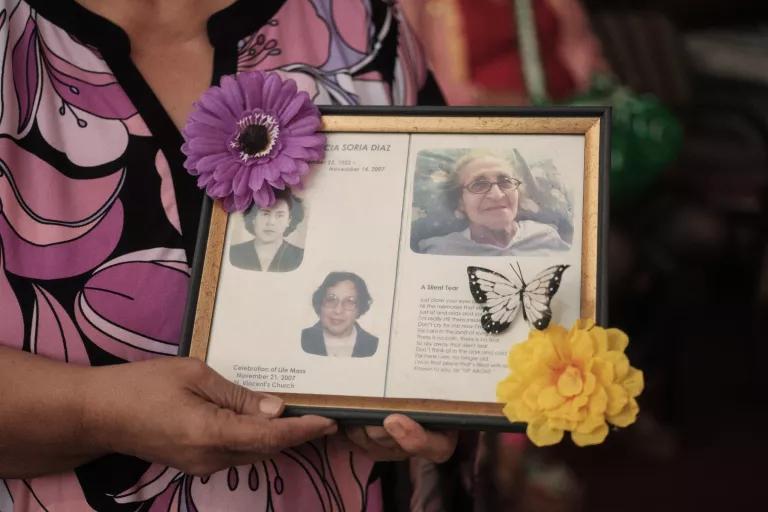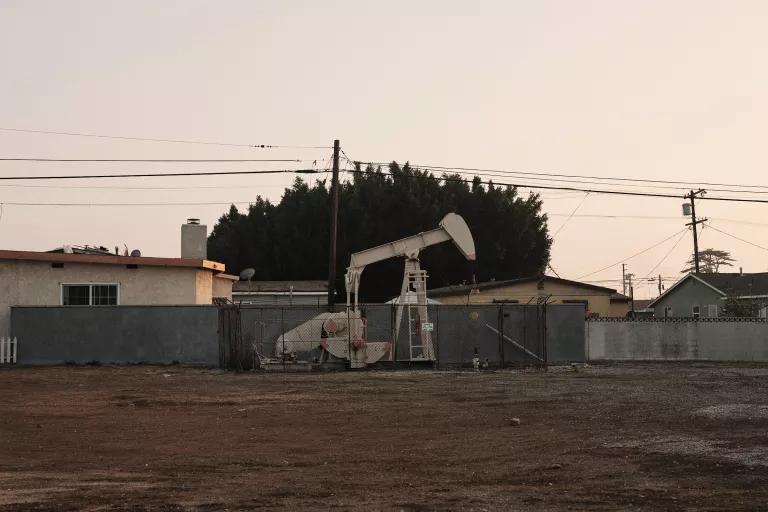Will Los Angeles Finally Put an End to Oil Drilling in Neighborhoods?
For close to a decade, the STAND-L.A. coalition has been calling on the city to stop extracting oil near homes and schools. Victory, at long last, is within reach.

Wendy Miranda suffered from health issues related to drilling around her neighborhood of Wilmington in Los Angeles.
Wray Sinclair for NRDC
UPDATE: On January 26, 2022, the Los Angeles City Council voted unanimously to support a ban on the creation of new oil wells in the city. After years of advocacy from frontline communities and environmental justice leaders, this vote is an important step toward completely phasing out oil drilling there—and addressing the serious health and environmental problems that stem from it.
When Pat Diaz’s mother, Lucrecia, started to get nosebleeds back in 1972, the family didn’t think much of it. The same went for Lucrecia’s persistent headaches. If anything, her daughter recalls, she blamed the 110 Freeway, built through their South Central Los Angeles neighborhood a few years after her mother bought a two-story Victorian in 1949. Only after talking to fellow University Park residents decades later, and after Lucrecia had passed away in 2007 at age 84, did Diaz realize her mother’s symptoms—and eventually her own headaches, loss of taste, and constant cough—were the likely result of oil drilling operations taking place just five blocks from their home.
“I never had the spontaneous nosebleeds like many did, but I couldn’t even finish a sentence without coughing,” says Diaz. And for this lifelong activist, who got her start in the Chicano Movement, those symptoms propelled her into speaking out against the drilling too.

Unable to escape the noxious emissions and determined to protect their community’s health, Diaz and other residents joined the People Not Pozos (People Not Wells) campaign. The mission of this environmental justice initiative, led by the local nonprofit Esperanza Community Housing, is to not only shut down the drilling operations but also to repurpose AllenCo Energy’s well site in a way that would benefit the predominantly Latino community.
“For the most part, people weren't really aware that there was oil drilling going on there. They were just baffled as to why all the kids and people were getting sick,” says Hugo Garcia, environmental justice campaign coordinator for Esperanza Community Housing. More and more residents, including many children, began complaining of foul odors and health problems soon after AllenCo boosted the drilling site’s oil production by 400 percent in 2010, using a chemical-heavy process called acidizing. The previous year, the company had leased the land—which is adjacent to homes and schools and had been an oil extraction site since 1963—from the Archdiocese of Los Angeles. “That’s when we really started asking questions and organizing and submitting formal complaints.” People Not Pozos didn’t just organize locally—they also called on the Pope for help. (The Pope did not respond.)

Close to 600,000 people in Los Angeles County, which has a long history of oil extraction, live within a quarter mile of an active drilling site. Oil wells, even those that are inactive, can release a range of toxic chemicals like benzene (a known carcinogen), potent greenhouse gases like methane, and high levels of particulate matter. Recent California-based research has linked living near oil wells with decreased lung function, asthma, and preterm birth, while other studies have connected fossil fuel extraction with cancer, cardiovascular problems, and reproductive harm, as well as nosebleeds and headaches like Diaz and her mother experienced.
When University Park community members began demanding action at the AllenCo site, residents and organizations in other L.A. neighborhoods, mostly low-income communities of color, were fighting similar battles. In 2013, as this public health issue started garnering national attention, ultimately pressuring AllenCo to voluntarily shut down, Esperanza Community Housing and six other groups joined forces as STAND-L.A. to call for an end to neighborhood oil drilling across the city. Now, after nearly a decade, that vision could soon come to be reality.
In September, the Los Angeles County Board of Supervisors voted unanimously to phase out oil drilling. This would entail shutting down and cleaning up wells within a specified phaseout period and banning new wells in unincorporated areas of the county, including within Inglewood Oil Field, the country’s largest urban oil field. As part of the plan, more than 1,600 active wells could shut down. Recently elected Supervisor Holly Mitchell led the charge, citing the fact that 73 percent of Angelenos living near oil and gas drilling are people of color as a major factor in her decision. STAND-L.A. members celebrated the momentous decision, along with Culver City’s vote earlier in the summer in favor of a phaseout, as a clear commitment to protecting communities and paving the way for a just transition toward a fossil-free future.
These moves help set the stage for the city of Los Angeles to move forward with its own phaseout plan, which could go to a vote in the coming months. “We’ve been fighting for this ordinance for over five years now,” says Alison Hahm, an attorney with Communities for a Better Environment (CBE), one of California’s leading environmental justice groups and a founding member of STAND-L.A. “The county board of supervisors’ vote puts a spotlight on the city because the county moved so deliberately, intentionally, and quickly. Our eyes are now on the city of L.A., and we’re going to hold its feet to the fire.” Nine of the 15 Los Angeles City Council members publicly expressed support for the county phaseout.
For residents like Wendy Miranda, who lives next to two plugged wells and five minutes from the Warren E&P drill site in the Wilmington oil field (the third largest in the country), a citywide phaseout can’t come soon enough. “Wilmington is nine square miles, but we are impacted by industry everywhere we go,” says the 25-year-old UCLA student and CBE intern. In addition to having hundreds of oil wells—70 percent of which are within 1,500 feet of a house, school, park, hospital, place of worship, or other “sensitive land use areas”—Wilmington, a predominantly Black and Latino neighborhood, is home to five oil refineries and two of the country’s busiest port complexes, the Port of Los Angeles and the Port of Long Beach. Diesel trucks and crude oil–carrying trains travel in and out all day, every day. “Growing up, my friends and I really thought that this was just normal to be surrounded by so much industry,” Miranda says, “But as we’ve gotten older, we realize it's not.”
Many of the people Miranda grew up with experienced nosebleeds, respiratory issues, and other health problems. In 1995, her mother was diagnosed with adult-onset asthma and now requires nebulizer treatments three times a day. Miranda herself uses an inhaler: She was shocked to find out at 19 that she’d also developed asthma. At the time, she had been a healthy and avid runner, training for a marathon, when she suddenly found herself wheezing and gasping for air after running just a quarter of a mile. “We shouldn't have to be dealing with this,” Miranda says, noting that she now has hope for an eventual phaseout in Wilmington too. “We deserve every right to breathe clean air—regardless of our race, regardless of our economic status, regardless of our zip code.”

Meanwhile, back in University Park, AllenCo’s fate still hangs in the balance since the company applied in 2018 to restart its drilling operations. Diaz, whose cough and headaches have subsided since the 2013 shutdown and whose sense of taste has started to return, reports that the announcement rattled her community but also sprang them back into action. But their wins have been interspersed by frustrating setbacks. For example, in March 2020, California regulators officially closed down the drilling site—its 21 wells, according to Diaz, have been sitting idle with just wooden boards placed loosely on top. But the company filed an appeal a couple of weeks later, and the case has yet to be heard due to delays related to COVID-19. And in August 2020, attorneys for the city of Los Angeles filed 25 criminal counts against AllenCo, cases which are also in limbo.
“We've been effective in our organizing and in our campaign to bring things to a head,” Garcia says. “Now we're kind of at a standstill, but there was a time before where we didn't have support from agencies that have oversight. Now they're taking action, and we feel pretty good about it, although we have to remain vigilant with them.”
Indeed, over the years, the STAND-L.A. coalition and its allies, including NRDC, have been able to shift public discourse around oil drilling. In April, California Governor Gavin Newsom announced a plan for the state to phase out oil extraction by 2045, and in mid-October, he unveiled a draft rule that would create 3,200-foot buffer zones between new wells and homes, schools, and other sensitive areas. This is a clear sign to advocates like Hahm that “oil is not in California's future, and toxic practices like neighborhood oil drilling are no longer slipping under the radar.”
Earlier in October, when an offshore pipeline spewed almost 25,000 gallons of oil into the Pacific Ocean, sullying Huntington Beach and wetlands elsewhere in Orange County, it was just another reminder of the dangers that fossil fuels bring to the land, water, and air around us, says Hahm, and of the need to move toward a clean energy future.
“L.A.'s frontline residents are all too familiar with the health and safety hazards caused by oil operations,” she says. “We can't close neighborhoods when oil disasters strike in our communities. There is no safe way to drill for oil in neighborhoods.”
This NRDC.org story is available for online republication by news media outlets or nonprofits under these conditions: The writer(s) must be credited with a byline; you must note prominently that the story was originally published by NRDC.org and link to the original; the story cannot be edited (beyond simple things such as grammar); you can’t resell the story in any form or grant republishing rights to other outlets; you can’t republish our material wholesale or automatically—you need to select stories individually; you can’t republish the photos or graphics on our site without specific permission; you should drop us a note to let us know when you’ve used one of our stories.


Six Ways to Help End Neighborhood Oil Drilling in California
An Oil Giant Is No Match for Resistance and Resilience in Richmond, California
Fossil Fuel Air Pollution Kills One in Five People